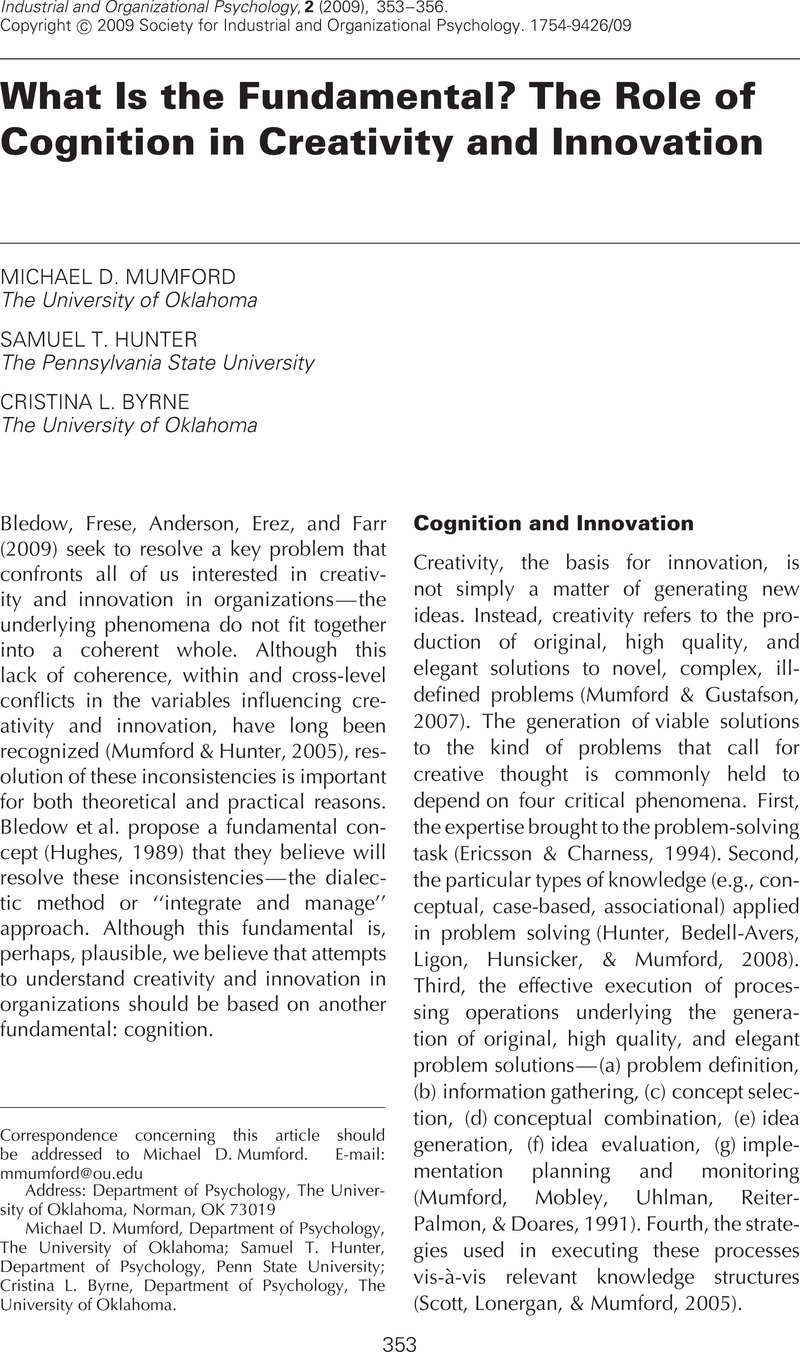Crossref Citations
This article has been cited by the following publications. This list is generated based on data provided by Crossref.
Bledow, Ronald
Frese, Michael
Anderson, Neil
Erez, Miriam
and
Farr, James
2009.
Extending and Refining the Dialectic Perspective on Innovation: There Is Nothing as Practical as a Good Theory; Nothing as Theoretical as a Good Practice.
Industrial and Organizational Psychology,
Vol. 2,
Issue. 3,
p.
363.
Manral, Lalit
2011.
Managerial cognition as bases of innovation in organization.
Management Research Review,
Vol. 34,
Issue. 5,
p.
576.
Rosing, Kathrin
Frese, Michael
and
Bausch, Andreas
2011.
Explaining the heterogeneity of the leadership-innovation relationship: Ambidextrous leadership.
The Leadership Quarterly,
Vol. 22,
Issue. 5,
p.
956.
Hunter, Samuel T.
Cushenbery, Liliya
and
Friedrich, Tamara
2012.
Hiring an innovative workforce: A necessary yet uniquely challenging endeavor.
Human Resource Management Review,
Vol. 22,
Issue. 4,
p.
303.
Meng, Yi
Zou, Liqing
He, Jia
and
Luo, Changkun
2015.
Supervisors’ leadership and health science researchers’ intrinsic motivation.
Nankai Business Review International,
Vol. 6,
Issue. 1,
p.
68.
Rooks, Gerrit
Sserwanga, Arthur
and
Frese, Michael
2016.
Unpacking the Personal Initiative-Performance Relationship: A Multi-Group Analysis of Innovation by Ugandan Rural and Urban Entrepreneurs.
Applied Psychology,
Vol. 65,
Issue. 1,
p.
99.
Auger, Pascale
and
Woodman, Richard W.
2016.
Creativity and Intrinsic Motivation.
The Journal of Applied Behavioral Science,
Vol. 52,
Issue. 3,
p.
342.
Mumford, Michael D.
and
McIntosh, Tristan
2017.
Creative Thinking Processes: The Past and the Future.
The Journal of Creative Behavior,
Vol. 51,
Issue. 4,
p.
317.
Ramesh, Sangaralingam
2018.
The Rise of Empires.
p.
17.
Costa, Vítor
and
Monteiro, Samuel
2018.
From Potential Absorptive Capacity to Knowledge Creation in Organisations: The Mediating Role of Knowledge Storage and Realised Absorptive Capacity.
Journal of Information & Knowledge Management,
Vol. 17,
Issue. 01,
p.
1850006.
Reiter-Palmon, Roni
Mitchell, Kevin S.
and
Royston, Ryan
2019.
The Cambridge Handbook of Creativity.
p.
515.
Sette, Guilherme
and
Brito, Pedro Quelhas
2020.
To what extent are digital influencers creative?.
Creativity and Innovation Management,
Vol. 29,
Issue. S1,
p.
90.
Reiter-Palmon, Roni
Royston, Ryan P.
and
Mitchell, Kevin S.
2021.
Creativity.
p.
242.
Alt, Dorit
Boniel-Nissim, Meyran
Naamati-Schneider, Lior
and
Meirovich, Adaya
2022.
Precursors of Openness to Provide Online Counseling: The Role of Future Thinking, Creativity, and Innovative Behavior of Future Online Therapists.
Frontiers in Psychology,
Vol. 13,
Issue. ,
Tekmen-Araci, Yasemin
and
Kuys, Blair
2022.
Ameliorating creativity in engineering education: Educator perspective.
Journal of Design, Business & Society
,
Vol. 8,
Issue. 2,
p.
211.
Liu, Dewen
Han, Shenghao
and
Zhang, Jieqiong
2022.
The golden mean: Research on the mechanism of customer participation in employee service innovation.
Journal of Retailing and Consumer Services,
Vol. 68,
Issue. ,
p.
103040.
Haim Faridian, Parisa
2023.
Leading open innovation: The role of strategic entrepreneurial leadership in orchestration of value creation and capture in GitHub open source communities.
Technovation,
Vol. 119,
Issue. ,
p.
102546.
Alt, Dorit
Kapshuk, Yoav
and
Dekel, Heli
2023.
Promoting perceived creativity and innovative behavior: Benefits of future problem-solving programs for higher education students.
Thinking Skills and Creativity,
Vol. 47,
Issue. ,
p.
101201.
Naamati-Schneider, Lior
and
Alt, Dorit
2024.
Technology and Competency-Oriented Learning.
p.
65.
Hernandez Sibo, Ingrid P.
Gomez Celis, David A.
and
Liou, Shyhnan
2024.
Exploring the Landscape of Cognitive Load in Creative Thinking: a Systematic Literature Review.
Educational Psychology Review,
Vol. 36,
Issue. 1,



